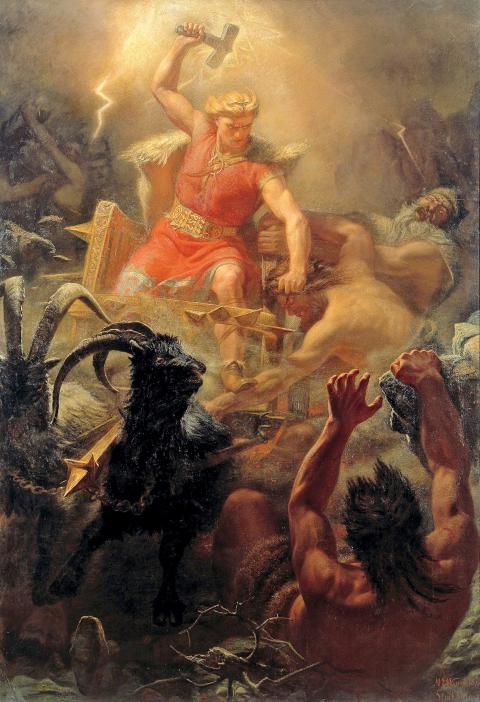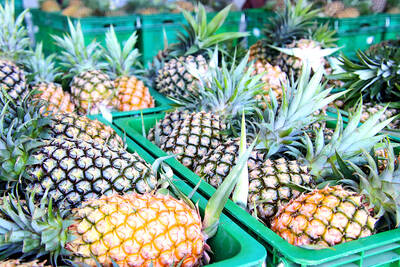Chinese Practice
殺雞用牛刀
(sha1 ji1 yong4 niu2 dao1)

Photo: Wikimedia Commons
照片:維基共享資源
use an ox knife to kill a chicken
中國古代的儒家思想認為音樂和禮儀是密切相關的;禮是秩序和美德的表現,樂則是要表達出教養和美德,也是陶冶自我、教化群眾的方法,以便將文化傳統和歷史代代相傳。
由《論語》的〈陽貨〉一章中,我們得知孔子曾到訪過魯國一個名叫武城的小城,該城是由孔子的弟子言偃(字子游)所治理。子游試圖用禮樂來教化武城人民,孔子到訪武城時,聽到陣陣樂聲傳來,他便微笑著跟子游說:「割雞焉用牛刀?」孔子一開始是感到莞爾,因為他的學生子游如此大費周章去教導這小城的人民,而子游的用心也讓孔子刮目相看。這樣做。子游對孔子所說的話稍感驚訝,說道:「老師,我曾聽您說,『做官的學道,就會愛恤人民;老百姓學道,就會容易接受指揮』。」孔子便跟子游保證說,子游這樣做完全正確的,他剛剛說的割雞焉用牛刀,只不過是在說笑罷了。由這則軼事,便演變出成語「殺雞用牛刀」或「割雞焉用牛刀」(為什麼要用牛刀殺雞?),意思是用過度的力量來完成一件事。
兩千五百年後,在世界的另一頭,有人在一八七八年的《蓋茨堡編纂者》中發表的一篇文章中寫道:「Don’t worry over little ills of life. It is like taking a sledge hammer to kill a fly」(別擔心生活中的一點點不如意,因為這就像用大錘去殺一隻蒼蠅)。
蒼蠅可以用尺或姆指壓扁。「sledgehammer」(長柄大錘)是一種有長柄和沉重錘頭的錘子,這樣的設計是用來產生最大的破壞力,或是用來把大釘子或木樁打進地下。長柄大錘和可以單手使用的普通槌子不同,大錘需要用兩手握住並向後舉,以蘊積最大的力量,然後向前揮打下去,利用擺動的勢頭讓大錘的重量產生最大的破壞力。長柄大錘可用來打壞鎖住的門、把籬笆柱打進地裡,或在採石場中將岩石擊碎。長柄大錘(sledgehammer)首見於十五世紀的英格蘭,「sledge」這個字是源於盎格魯撒克遜字「slaligan」,原意為「猛烈地打擊」,與「slay」(殺戮)一字有關;古英語則有「slegebytel」一字,其中的「slege」和「bytel」(與「beat」一字有關),皆意指「hammer」(錘子)。
用長柄大錘來殺死蒼蠅,可說是用了太過度的殺傷力。
「taking a sledge hammer to kill a fly」(用長柄大錘殺一隻蒼蠅)這片語有數種版本,都是表達用了過多的力量──因此是不合理的。這些不同說法皆源於美國,包括「to kill a fly」(殺死蒼蠅)或「to crack a nut」(破壞堅果(或花生))。
現今最常用的版本是「use a sledgehammer to crack a nut」(用長柄大錘來打破堅果),此語首見於一九五○年代。
(台北時報林俐凱譯)
老婦才偷挖了一株價值五元的波斯菊,就被埋伏的員警上手銬逮捕,遭批殺雞用牛刀、用大砲打小鳥,不符法律中的比例原則。
(That old woman only stole a garden cosmos worth NT$5, but she was arrested and handcuffed by the police. The public criticized them for using a sledgehammer to crack a nut, saying that the response was disproportionate.)
你買這麼高階的電腦只是要做文書處理?太浪費了!殺雞焉用牛刀?
(Are you buying such a high-end computer just to use it as a word processor? What a waste. Why use a sledgehammer to crack a nut?)
英文練習
use a sledgehammer to crack a nut
In ancient China, Confucian thought viewed music and ritual to be intimately related; where ritual was the manifestation of order and virtue, music was regarded as the expression of cultivation and virtue, as well as a means to cultivate oneself and the masses and a way to transmit cultural traditions and histories from one generation to the next.
In the yanghuo chapter of the lunyu (Analects), we are told of how Confucius once visited a small town called Wucheng in the state of Lu, governed by a disciple of Confucius named Yan Yan (Zi You). Zi You sought to educate the people of Wucheng using music and the rites, and when Confucius visited he heard the sound of music being played. Smiling, he turned to Zi You and said 割雞焉用牛刀 (“why use an ox knife to kill a chicken?”) Confucius was at once amused that his disciple was going through such lengths to educate the townsfolk and also impressed that he would do so. Yan Yan, taken slightly aback at Confucius’ words, said, “Master, I have heard you say that the cultivated gentleman loves people, and the cultivated commoner is easily ruled.” Confucius reassured him, saying that he was completely correct, and that he had only been speaking in jest about the chicken and the ox knife. Still, the anecdote gives us the idioms 殺雞用牛刀 or 割雞焉用牛刀 (why use an ox knife/to kill a chicken?), meaning to use excessive force to complete a given task.
Two-and-a-half millennia later, in another part of the world, someone would write, in a piece published in Gettysburg Compiler in 1878, “Don’t worry over little ills of life. It is like taking a sledge hammer to kill a fly.”
A fly can be squished with a ruler or a thumb. A sledgehammer is a type of hammer with a long handle and a heavy head designed to create maximum destructive force or to drive large nails or wooden posts into ground. Unlike with ordinary hammers, which can be used with a single hand, sledgehammers require the wielder to hold it with two hands and to swing it with all the force they can muster, using the momentum created by the sheer weight of the head to cause the required damage. They can be used in bashing down locked doors, driving in fence posts or breaking up rocks in a quarry. Sledgehammers were first used in England in the 15th century, and the word “sledge” itself derives from the Anglo Saxon slaegan, which originally meant “to strike violently,” related to the word “slay,” and Old English had slegebytel, where both slege and bytel (related to “beat”) meant “hammer.”
To use that to kill a fly could be considered overkill.
Variants of the phrase “taking a sledge hammer to kill a fly” to express excessive — and therefore unwarranted — force, all come from the US, and include “to kill a fly” or “to crack a nut (or peanut).”
The most commonly used variant today is to “use a sledgehammer to crack a nut.” This first appeared in the 1950s.
(Paul Cooper, Taipei Times)
Calling a meeting with all the department heads, rather than having a quiet word with those responsible, is a little extreme. Why take the sledgehammer approach?
(不去跟負責的人私下溝通,卻把所有部門主管都叫來開會,這樣做有點太過火了。殺雞為何用牛刀?)
I’ve been accused of using a sledgehammer to crack a nut over this, but I just wanted to make absolutely sure it got done.
(我被批評是殺雞用牛刀,但我只是想要完全確認這件事有辦好。)

A: What types of fruit enzymes should we take to help reduce eye floaters? B: According to a study published in the “Applied Sciences” journal by Taiwanese ophthalmologist Horng Chi-ting, pineapple, papaya and fig supplements can improve symptoms. A: Pineapples are in season now, so you should munch on more of those to get rid of floaters. B: Not quite. Enzymes can be damaged by our stomach acid if we eat the fruit directly. The doctor says taking fruit enzyme capsules is better for absorption. A: Most importantly, we should reduce our use of personal electronics to prevent floaters from

Rice is essential to Japanese culture, tradition and politics. People take pride in the oval-shaped sticky Japonica grain, which is still a staple even though total consumption has fallen over the decades. But since last summer, prices have soared as supplies have fallen short of demand. The government has long paid farmers to cut back on rice acreage, and change to other crops to keep rice prices relatively high. To cope with shortfalls this year, the government has released rice reserves. But the grain has been slow to reach supermarket shelves. Anger over that was part of the reason the Agriculture Minister

In Taiwan, 7-Eleven convenience stores can be found on almost every street corner. With over 84,600 stores across 20 countries, 7-Eleven has more locations than any other retail business on Earth. For millions of people, the chain is an important part of daily life, providing coffee, quick meals, and essential items for those __1__. The history of 7-Eleven began nearly 100 years ago in Dallas, Texas. In 1927, the Southland Ice Company began selling blocks of ice that were used to keep fridges cool. Shortly after opening, the company __2__ its offerings to include groceries like milk, eggs, and

Continued from yesterday(延續自昨日) https://www.taipeitimes.com/News/lang In 1946, the company adopted the name 7-Eleven to reflect its newly extended __3__, from 7am to 11pm, a novel concept at the time. As a rapidly growing company, it began offering franchise opportunities in the 1960s. In 1974, the first 7-Eleven in Japan was opened by the supermarket company Ito-Yokado. The Japanese franchises were __4__ successful that by 1991, Ito-Yokado was able to acquire a 70 percent stake in Southland Corporation. Its investments eventually resulted in full ownership of 7-Eleven, which paved the way for the Japanese company to enter the international market. Since then, 7-Eleven